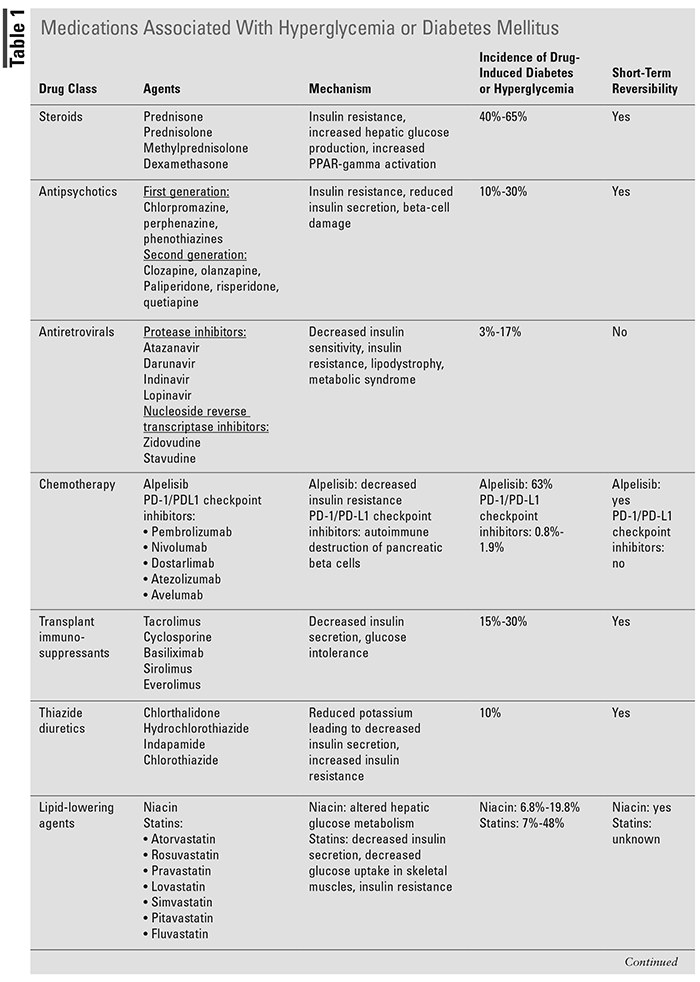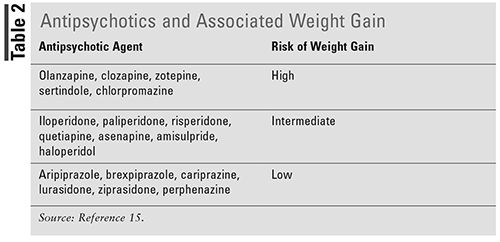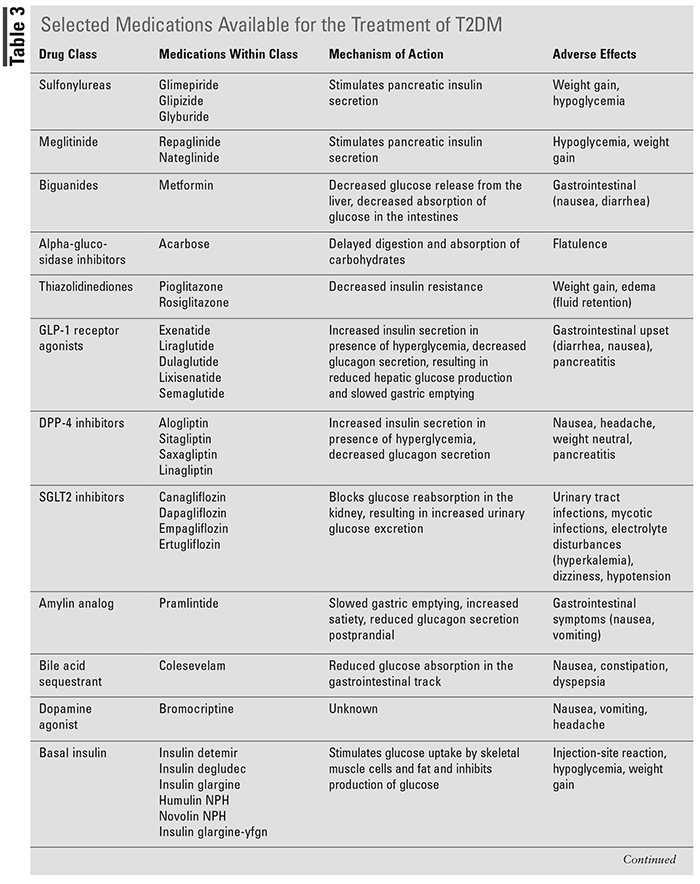US Pharm. 2021;46(11):18-30.
ABSTRACT: Certain medications and medication classes have adverse effects that can induce other medical conditions. Two adverse events of importance are hyperglycemia and diabetes. Among medications that can induce hyperglycemia and diabetes are alpelisib, antipsychotics, and antiretrovirals; thus, proper management strategies are necessary when they are prescribed. Uncontrolled hyperglycemia can increase the risk of microvascular and macrovascular complications; therefore, early detection and management are crucial for avoidance of these issues. In some cases, the hyperglycemia or diabetes can resolve with medication cessation, or alternative therapy may lower the risk of associated hyperglycemia. Ultimately, shared decision-making between patients and providers is necessary for improved health outcomes.
Diabetes is a chronic medical condition characterized by hyperglycemia resulting from insufficient insulin production and/or insulin resistance.1 As of 2018, the CDC reported that 10.5% of the U.S. population, or 34.2 million people, have a diagnosis of diabetes.2 There are many risk factors for diabetes including genetic predisposition, obesity, minority race/ethnicity, family history of diabetes, physical inactivity, older age, and comorbidities such as HIV.3 Another risk factor for diabetes is the use of certain medications and medication classes. These medications carry the risk of causing hyperglycemia and, eventually, diabetes.
Drug-induced diabetes is defined as diabetes resulting from the use of medication. Key medication classes to monitor due to risk of drug-induced diabetes are listed in TABLE 1, as well as specific agents, mechanisms of causing diabetes, incidence, and short-term reversibility.3-7 Drug-induced diabetes or hyperglycemia can be caused via multiple mechanisms. These include insulin resistance, increased hepatic glucose production, decreased insulin secretion, glucose intolerance, and autoimmune destruction of beta cells, among others. It is important to note that drug-induced diabetes typically results from higher doses and long-term use of the offending agents. In this article, there will be a focus on the following medications and medication classes: alpelisib, antipsychotics, and antiretrovirals.


Alpelisib
Alpelisib, an oral phosphatidylinositol-3 kinase (PI3K) alpha inhibitor, was approved for use in combination with fulvestrant in patients with hormone receptor–positive, human epidermal growth factor receptor 2 (HER2)-negative advanced or metastatic breast cancer with PIK3CA mutations.8 In clinical studies, 63% of subjects developed hyperglycemia, and 0.7% developed diabetic ketoacidosis.9 There have been several postmarketing case reports regarding alpelisib-induced diabetic ketoacidosis.10,11
PI3K is an important factor in a cell’s physiology and is involved in cellular growth, lipid metabolism, protein synthesis, and glucose homeostasis. The PI3K/protein kinase B (Akt) pathway impacts glucose homeostasis. Additionally, altered Akt can cause decreased insulin secretion from the beta cells within the pancreas.12 There are no specific treatment guidelines for alpelisib-induced hyperglycemia; however, metformin was most frequently used in the SOLAR-1 trial.13 Additional diabetes medications may be warranted based on severity of hyperglycemia, and alpelisib doses may need to be adjusted while obtaining tighter glycemic control. Hyperglycemia caused by alpelisib is reversible when alpelisib is discontinued.11
Antipsychotics
First- and second-generation antipsychotics have known adverse effects including weight gain and cardiometabolic disorders. TABLE 2 shows multiple antipsychotics and risk of weight gain with each agent.14,15 Approximately 10% of people who take antipsychotic medications develop new-onset diabetes.15 Antipsychotic-induced diabetes has multiple mechanisms, including the direct effect from the drug, reduced insulin secretion, insulin resistance through obesity, and beta-cell dysfunction.16 Studies have shown that insulin resistance due to antipsychotics can be independent of weight gain.16 Antipsychotic-induced obesity is correlated with increased appetite and food intake by antagonism of serotonin 5-HT2C (5-hydroxytryptamine 2C), histamine H1, and dopamine D2 receptors.16 Studies in rodents have shown that olanzapine inhibition of 5-HT2C has induced weight gain and overeating.15-17 There is limited research regarding dose-specific antipsychotic risk of developing diabetes. In one study, it showed the risk of developing diabetes was dose-dependent for patients treated with olanzapine, quetiapine, and risperidone, while aripiprazole and ziprasidone were not dose-dependent.18 Additional research is needed in this area.

When treating patients with antipsychotics, therapy should be an antipsychotic with low risk of metabolic disturbances that adequately controls the psychiatric disorder.15 Antipsychotic agents should not be abruptly stopped, and if changed, they require close monitoring to prevent relapse. There are many available treatment options for diabetes, and it may be beneficial to select an agent that is associated with weight loss or to choose a glycemic agent that provides cardiovascular benefits.
Antiretrovirals
HIV is a virus that weakens the immune system by destroying CD4 T-lymphocyte cells that fight disease and infection. The viral disease increases risk of elevated blood glucose via inflammation, pancreatic beta-cell changes, and increased insulin resistance.19 Although the disease itself increases risk of elevated glucose, certain medications used to treat HIV are also thought to increase the risk of insulin resistance and diabetes. These include older protease inhibitors (PIs) and nucleoside reverse transcriptase inhibitors (NRTIs).3,19
The mechanism of action of PIs includes inhibition of the protease enzyme and prevention of posttranslational cleavage of polyproteins into active proteins. Therefore, new, mature HIV is not assembled. NRTIs work by incorporating into the growing HIV DNA and inhibiting reverse transcriptase, which causes chain termination.20 Between 3% and 17% of patients taking highly active antiretroviral therapy, including PIs, report hyperglycemia with or without diabetes.3 It is not recommended to discontinue antiretroviral therapy due to drug-induced diabetes or hyperglycemia; however, there are options for reducing risk of these adverse effects. If possible, patients on older NRTIs such as zidovudine can be switched to a first-line NRTI such as abacavir, tenofovir alafenamide, or tenofovir disoproxil fumarate when appropriate. These agents carry a lower risk of metabolic abnormalities such as hyperglycemia. Additionally, patients on a PI-based regimen can be considered for an integrase strand transfer inhibitor (INSTI)-based regimen, which is recommended as first-line therapy.21 However, if a patient is stable on a PI-based regimen, has documented intolerance to the suggested medications, or has noted resistance to the recommended first-line agents, continuation with close monitoring of glucose values is a reasonable approach.
If a patient with HIV is diagnosed with diabetes or insulin resistance, consider referral to an endocrinologist. Clinical pharmacists are also an excellent resource to help determine guideline-recommended agents to initiate while ensuring correct dosing and assessing drug-drug interactions. For those at risk of diabetes without a diagnosis, monitor fasting blood glucose every 6 to 12 months to assess progression to diabetes mellitus. This method is preferred and more accurate than monitoring hemoglobin A1C in HIV, as there is possibly increased RBC turnover that may lead to falsely lower A1C.22 All patients with HIV who are on antiretroviral therapy should be counseled about lifestyle modifications, including implementation of a diet low in saturated fat, trans fat, and cholesterol. Increased physical activity should also be encouraged.22
Monitoring and Management
When patients are started on medications that have the potential to cause hyperglycemia or induce diabetes, they should be counseled on signs and symptoms of hyperglycemia. Key signs of hyperglycemia include polyuria, polydipsia, and polyphagia. If symptoms occur, patients should seek follow-up with a medical professional.
Once hyperglycemia or diabetes is identified, monitoring of blood glucose and A1C on a routine basis is needed to guide treatment options. For most agents that can cause drug-induced diabetes, the monitoring frequency for A1C ranges from every 3 months to every 12 months. A complete basic metabolic panel should be evaluated to assess diabetic ketoacidosis as well as renal function, which is important when choosing an antihyperglycemic agent. Continuous glucose monitors may be helpful to check glucose values for patients who prefer to avoid fingerstick. The level of hyperglycemia, reversibility of the hyperglycemia, key laboratory values, pharmacodynamic/pharmacokinetic principles, and comorbidities will guide treatment options. For instance, alpelisib can significantly elevate blood glucose and is usually treated with basal/bolus insulin for the duration of alpelisib therapy. Insulin therapy needs to be adjusted if the alpelisib dose is decreased or discontinued. Another example includes HIV medications such as dolutegravir, an INSTI, which interacts with metformin by causing increased concentrations of metformin.23 Therefore, it is recommended to consider an alternative or use lower doses of metformin, such as 1,000 mg daily maximum, when used in combination with dolutegravir.
The American Diabetes Association releases Standards of Medical Care in Diabetes each year that provides guidance on diabetes management. First-line therapy for type 2 diabetes management includes metformin, unless a contraindication, and comprehensive lifestyle modifications.24 Additional glycemic agents may be chosen depending on high risk or established chronic kidney disease, heart failure, or atherosclerotic cardiovascular disease.24 TABLE 3 includes some available medications for treatment of type 2 diabetes and common adverse effects. Note that combination products are not listed. Treatment regimens should be individualized, and shared decision-making should occur between the patient and physician when determining medication therapy.


Pharmacist’s Role
Pharmacists hold a vital role in identifying and managing drug-induced hyperglycemia or diabetes. Across all patient care settings, pharmacists can identify agents that can cause drug-induced diabetes during medication reconciliations and comprehensive medication reviews. Once identified, pharmacists can suggest alternative agents, clarify duration of treatment, or suggest guideline-directed treatment when needed and as appropriate. Pharmacists can also provide blood-glucose and A1C monitoring parameters based on the patient’s diabetes status. For those without diabetes, counseling on lifestyle modifications to help prevent progression to diabetes is beneficial. Regular monitoring of blood glucose and hemoglobin A1C is also important to ensure the patient has not progressed to a diabetes diagnosis. A patient with prediabetes may benefit from initiating metformin, which is a commonly used medication in the prediabetic population. In patients with established diabetes, pharmacists can recommend guideline-directed medical therapy for diabetes management after assessing appropriateness of treatment, including contraindications or drug interactions. Diabetes control is crucial for prevention of microvascular and macrovascular diabetes complications.
Pharmacists are one of the most accessible healthcare professionals, allowing for consistent follow-up with patients between physician appointments. Pharmacists are also able to report medication adverse effects and events through the FDA MedWatch. This can ultimately improve health outcomes and reduce further comorbidities and healthcare costs.
Conclusion
Drug-induced diabetes is one of the many potential causes of a diabetes diagnosis. It is imperative that pharmacists and other healthcare providers have an understanding of medications with a higher risk for hyperglycemia and diabetes. Shared decision-making should take place between the prescribing physician and patient when considering drug therapy to treat a condition. Patients should be counseled and given information on risk versus benefit of these medications as well as potential adverse events. With this knowledge, patients are more likely to seek medical attention if issues occur, such as symptoms of hypoglycemia or hyperglycemia, medication access, or adverse events. Pharmacists can also assist with close monitoring of relevant laboratory values as well as lifestyle and medication management. Fortunately, with proper diabetes education and the vast number of medications available for diabetes, a patient’s conditions can be managed appropriately if an offending medication is needed for continuity of care.
The content contained in this article is for informational purposes only. The content is not intended to be a substitute for professional advice. Reliance on any information provided in this article is solely at your own risk.
REFERENCES
1. Kahn SE, Cooper ME, Del Prato S. Pathophysiology and treatment of type 2 diabetes: perspectives on the past, present, and future. Lancet. 2014;383:1068-1083.
2. CDC. National diabetes statistics report, 2020. https://www.cdc.gov/diabetes/data/statistics-report/index.html?CDC_AA_refVal=https%3A%2F%2Fwww.cdc.gov%2Fdiabetes%2Fdata%2Fstatistics%2Fstatistics-report.html. Accessed August 25, 2021.
3. Luna B, Feinglos MN. Drug-induced hyperglycemia. JAMA. 2001;286:1945-1948.
4. Anyanwagu U, Idris I, Donnelly R. Drug-induced diabetes mellitus: evidence for statins and other drugs affecting glucose metabolism. Clin Pharmacol Ther. 2016;99:390-400.
5. Chen J, Huang XF, Shao R, et al. Molecular mechanisms of antipsychotic drug–induced diabetes. Front Neurosci. 2017;11:643.
6. Jain V, Patel RK, Kapadia Z, et al. Drugs and hyperglycemia: a practical guide. Maturitas. 2017;104:80-83.
7. Zhang R, Cai XL, Liu L, et al. Type 1 diabetes induced by immune checkpoint inhibitors. Chin Med J (Engl). 2020;133:2595-2598.
8. Piqray (alpelisib) package insert. East Hanover, NJ: Novartis Pharmaceuticals Corporation. Revised July 2021.
9. André F, Ciruelos E, Rubovszky G, et al. Alpelisib for PIK3CA-mutated, hormone receptor–positive advanced breast cancer. N Engl J Med. 2019;380:1929-1940.
10. Carrillo M, Rodriguez RM, Walsh CL, Mcgarvey M. Alpelisib-induced diabetic ketoacidosis: a case report and review of literature. AACE Clin Case Rep. 2020;7:127-131.
11. Nguyen P, Musa A, Samantray J. Alpelisib-induced diabetic ketoacidosis. Cureus. 2020;13(5):e14796.
12. Huang X, Liu G, Guo J, Su Z. The PI3K/AKT pathway in obesity and type 2 diabetes. Int J Biol Sci. 2018;14:1483-1496.
13. Rugo HS, André F, Yamashita T, et al. Time course and management of key adverse events during the randomized phase III SOLAR-1 study of PI3K inhibitor alpelisib plus fulvestrant in patients with HR-positive advanced breast cancer. Ann Oncol. 2020;31:1001-1010.
14. Dayabandara M, Hanwella R, Ratnatunga S, et al. Antipsychotic-associated weight gain: management strategies and impact on treatment adherence. Neuropsychiatr Dis Treat. 2017;13:2231-2241.
15. Cernea S, Dima L, Correll CU, Manu P. Pharmacological management of glucose dysregulation in patients treated with second-generation antipsychotics. Drugs. 2020;80:1763-1781.
16. Chen J, Huang XF, Shao R, et al. Molecular mechanisms of antipsychotic drug-induced diabetes. Front Neurosci. 2017;11:643.
17. Citrome L, Collins JM, Nordstrom BL, et al. Incidence of cardiovascular outcomes and diabetes mellitus among users of second-generation antipsychotics. J Clin Psychiatry. 2013;74(12):1199-1206.
18. Ulcickas Yood M, DeLorenze GN, Quesenberry CP Jr, et al. Association between second-generation antipsychotics and newly diagnosed treated diabetes mellitus: does the effect differ by dose? BMC Psychiatry. 2011;11:197.
19. Panel on Antiretroviral Therapy and Medical Management of Children Living with HIV. Guidelines for the use of antiretroviral agents in pediatric HIV infection: insulin resistance, asymptomatic hyperglycemia, diabetes mellitus [Table 15f]. https://clinicalinfo.hiv.gov/sites/default/files/guidelines/documents/PedARV_GL.pdf. Updated April 7, 2021. Accessed August 25, 2021.
20. Spach DH. Antiretroviral medications and initial therapy. National HIV Curriculum. https://www.hiv.uw.edu/go/antiretroviral-therapy/general-information/core-concept/all. Updated June 4, 2021. Accessed August 25, 2021.
21. Panel on Antiretroviral Guidelines for Adults and Adolescents. Guidelines for the use of antiretroviral agents in adults and adolescents with HIV: limitations to treatment safety and efficacy. https://clinicalinfo.hiv.gov/en/guidelines/adult-and-adolescent-arv/adverse-effects-antiretroviral-agents. Updated June 3, 2021. Accessed August 25, 2021.
22. American Diabetes Association. Comprehensive medical evaluation and assessment of comorbidities: Standards of Medical Care in Diabetes–2020. Diabetes Care. 2020;43(suppl 1):S37-S47.
23. Tivicay (dolutegravir) package insert. Research Triangle Park, NC: ViiV Healthcare. Revised July 2021.
24. American Diabetes Association. 9. Pharmacologic approaches to glycemic treatment: Standards of Medical Care in Diabetes–2021. Diabetes Care. 2021;44(suppl 1):S111-S124.
25. Wexler DJ. Management of persistent hyperglycemia in type 2 diabetes mellitus. UpToDate. https://www.uptodate.com/contents/management-of-persistent-hyperglycemia-in-type-2-diabetes-mellitus. Accessed October 11, 2021.
To comment on this article, contact rdavidson@uspharmacist.com.





